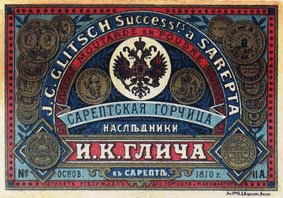History of Sarepta Mustard
The history of Sarepta mustard, which gave its name to the house in St. Petersburg, is quite interesting. In the eighteenth century, Russia was buying mustard in England. However, in the early nineteenth century it became difficult to supply mustard because Napoleon had established a continental blockade and British ships could not distribute their goods. In Sarepta there was plenty of wild mustard. Conrad Neitz, a talented producer, introduced a new type of mustard using English and French varieties. In 1802, he built a hand-mill and with its help produced mustard. However, with demand mustard increasing year by year he built a mill driven by horses in 1810. In the same year he served the mustard at the Emperor’s table, for which Alexander I awarded him a gold watch. The mustard was sold throughout Russia and abroad.

In St. Petersburg the house of the Sarepta Company, presented by Catherine II, was called the Sarepta or Mustard House. Two circumstances coincided - the original color of the house was mustard and the most famous product from Sarepta was mustard. Nowadays the Volgograd Sarepta mustard oil mill is a descendant of those early creameries and retains the historic name of the settlement. Its products can be found in major supermarkets in St. Petersburg. The plant is Russia's largest mustard mill.


